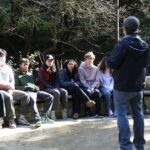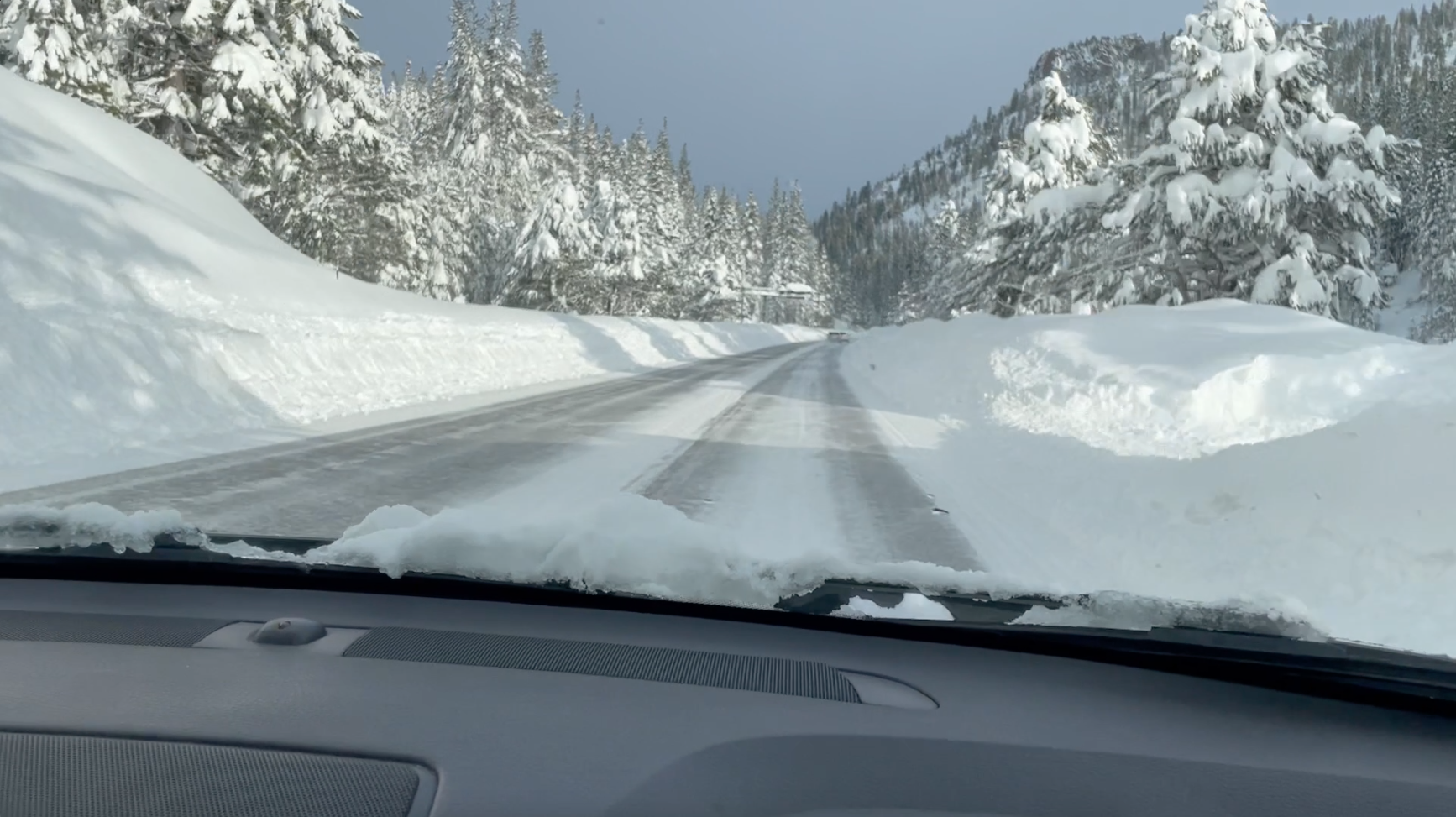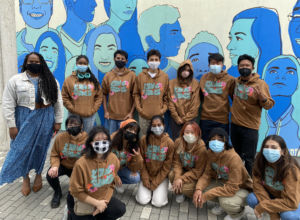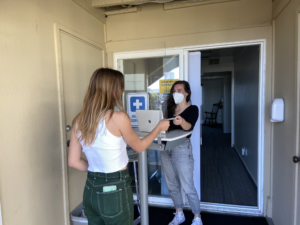On Tuesday morning, December 28, 2021, I woke up to the sound of my dad’s muffled footsteps approaching my bed on the unfamiliar carpeted floors of our rental. I rolled over to find him shaking my brother awake in the top bunk.
My dad told us it was time to get up, pack up the car and get going. At the sound of this news, I jumped out of bed. The metal frame of the bunk bed clanged as my brother descended the ladder. After 38 long hours of anticipation, the time had finally come for us to journey home.
We had been snowbound in Tahoe since our scheduled departure date: Saturday, December 26. We had been stuck for two days in our Tahoe rental because the two most direct routes back to the Bay Area — Interstate 80 and Highway 50 — were closed. Once my dad woke us up, we were packed and ready to go in 20 minutes, definitely a family record. The adrenaline from the thought of finally returning to our own home spurred us on. Our plan was to drive to the Truckee entrance to 80 westbound and wait there until it opened. In the car, my mom relentlessly refreshed the Caltrans Twitter page, waiting for the announcement that 80 was open for passenger vehicles.
Once we got there, we found the road with a surprising lack of blockades: at the sight of this, I scrambled to find my phone. To my disappointment, I found a notification from only seconds earlier that the roads were still closed. Looking around, I saw many cars in our position, also hovering by the entrance to I-80.
We eventually decided that there was enough time to wander around Truckee and get something to eat. Every once in a while we could see a couple cars speed by towards the entrance to 80 and we would rush back to our car, thinking that we had somehow missed the announcement that we could leave. We became more and more impatient.
Alas, 80 westbound would not be open for 12 more hours.
By noon, Highway 50, was open. 50 descends the mountains from South Lake Tahoe, is smaller and begins at a lower elevation than 80. However, 80, the most direct route, out was still closed. Many decided to take the long route around the lake and pass through Nevada to get to 50. The roads leading to 50 were barely crawling — so many people were trying to get out.
By 5 p.m., 80 eastbound had opened for passenger traffic. People could enter Tahoe but could not exit.
The traffic on Highway 50 got so bad that the Nevada governor declared a state of emergency around 9 p.m. Cars attempting to take the long route to 50 were turned back.
Minutes after the governor’s announcement, Highway 80 opened to westbound traffic. Two and a half-days after we planned to leave and after 17 hours spent sitting in our car waiting, my family arrived home at 3 a.m. on Wednesday morning.
In December 2021, North Tahoe and the Sierras saw almost 18 feet of snowfall, breaking a record set almost one and a half centuries ago. Heavy snow caused bad road and visibility conditions, and as a result Interstate 80 closed on December 25 and Highway 50 closed on December 26. 50 would remain closed until midday on December 28, and 80 would remain closed until later that night. In addition to road closures, the storm piled up snow onto the Sierras and surrounding towns. Many ski lifts and entire resorts were shut down, gas stations ran out of gas, roads were closed, visitors were stranded for even longer, cars were buried in snow and people were trapped in their homes.
The big questions for me that arose from the many hours I had to think about this experience were: why was this storm so intense and why were roads closed for days?
After some research, I found that the storm’s intensity was because of extreme weather conditions caused by climate change.
Many people think of climate change only as causing global temperatures to rise. However, climate change causes extreme weather at both ends of the spectrum — extreme cold, extreme precipitation and extreme heat.
As it snowed in Tahoe, extreme rain poured down on the Bay Area — so much rain that once we escaped from the snow of the mountains, our car’s windshield wipers set on high could not keep up with the flood of rain falling on our car.
According to the United States Environmental Protection Agency (EPA), climate change appears to be the cause of many intense but short term storms. Data shows that “nine of the top 10 years for extreme one-day precipitation events have occurred since 1996,” according to the EPA article, “Climate Change Indicators: Weather and Climate.”
While the Tahoe storm lasted much longer than one day, it was the severity of the storm on a day to day basis and a lack of breaks in precipitation that made it so difficult to get roads and businesses open — even for just 24 hours — in the middle of the storm.
The correlation between climate change and intense precipitation has to do with the principle of the water cycle — that evaporation occurs during warmer weather. With overall global temperatures increasing, more water evaporates and turns into clouds that later cause more severe precipitation.
I cannot remember any time when there was a break in the snow for longer than a few hours between the afternoon on December 26 when I was supposed to return to the Bay Area and the night of December 28, the time we actually got on the road.
To answer my second question, I dug into the reasoning behind Caltrans’ decisions regarding which roads to clear first and the communication between the Nevada Governor and California agencies.
According to Caltrans District 3 Public Information Officer Raquel Borrayo, the order in which highways and interstates reopen depends simply on which roads have the least snow to clear. Highway 50 is a smaller highway at a lower elevation, making it easier to clear.
Borrayo explained why this storm in particular caused so many road closures. “There was a lot of snowfall in a short period of time coupled with high winds that caused whiteout conditions and toppled trees,” she said.
There were several additional issues for Caltrans in clearing the roads. One was that drivers were not listening to safety guidelines when roads reopened earlier on in the storm causing incidents and more closures. Another issue was that when power lines were knocked down by the high winds and heavy snow, Caltrans and local utility companies had to coordinate their removal.
Additionally, the snowfall was extreme and required special equipment. The most effective way of clearing roadways with such large amounts of snow is to use a snow blower after snow plows and graders have cleared as much snow to the side of the road as possible. Graders move very slowly.
When asked about the situation with the Nevada State governor turning cars around on the stretch of 50 that leaves California, Borrayo said that this kind of situation does not happen often where other states get involved with closing highway access between connecting states.
“As far as I am aware, they did not alert us that they were going to (turn cars around at the border). They were experiencing a significant amount of traffic on their roads of just people trying to use Nevada to connect back into California and it’s up to them to make the best decisions for their residents,” she said.
While this storm was frustrating for people trying to get in and out of the Sierras, it is very important to remember that the crews clearing these roads are humans, working 12 hour shifts and doing the best they could.
When I was stuck in my family’s car trying to entertain myself, I got very deep into some Twitter feeds with a diverse mix of people thanking Caltrans for the work they were doing, while others complained about the speed at which roads were reopening and what they saw as a lack of communication.
As an example, in response to Caltrans District 3 and other local highway agencies’ Twitter announcements regarding the road closures around Christmas, their followers had varying responses. One Twitter user replied to an earlier Tweet about the closures, sarcastically: “Zero Visibility?? Who could have seen that coming??? Said everyone with no access to any form of media or social media!!!!” This response shows the user’s frustration with the use of Twitter and other forms of social media as the main and most reliable method of communicating important information such as road closures.
Another user had a very different response to hearing about the closures and backups: “Thank you for this update! And for all your hard work. This is quite remarkable!! Lots of snow,” they wrote.
Lots of other replies include Twitter users asking questions and for advice about the situation, both from Caltrans themselves and other people in similar situations.
In response to the heavy stream of questions and negative comments, Caltrans would release photos and videos of what the roads actually looked like and people working to open them and clear the back up.
It is okay to be upset or frustrated with these kinds of situations, but as Borrayo said, “we’re dealing with Mother Nature. We have no control over Mother Nature and what it brings, whether it be downed trees, downed power lines, massive amounts of snow fall or rain. People have to keep that in mind when they’re making travel plans that these types of storm systems are likely to continue happening in the future and prepare accordingly.”
The people clearing the roads are not to blame for the storms, nor is anyone else. We should be focusing our time and energy on being gracious and making life as easy as possible for the workers who dedicate entire days to making travel possible.
In addition to Borrayo’s advice about planning ahead around storms, there are a few other things to keep in mind when in this kind of situation. Drive slow. Be responsible with gas — we were lucky enough to have refilled our tank before gas stations ran out. Some of our friends were not. Have necessary survival items in the car with you (food, water, flashlights, extra clothes and blankets). Overall, prioritize safety above all else.







